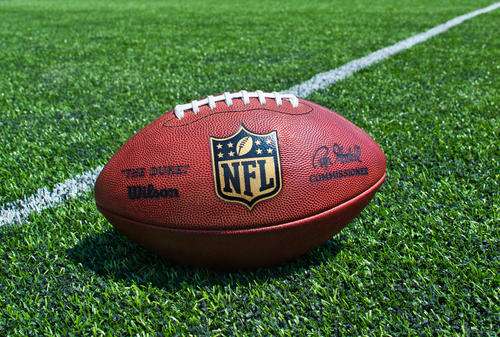Tests Show NFL Brain Damage May Linger, Start Young
 After the highly charged Super Bowl, two sobering studies emerged. One unveiled an improved molecular imaging technology that verified—and precisely identified—brain damage in some National Football League (NFL) players.
After the highly charged Super Bowl, two sobering studies emerged. One unveiled an improved molecular imaging technology that verified—and precisely identified—brain damage in some National Football League (NFL) players.
The other study revealed that brain damage can be more severe in NFL players who start playing football before age 12.
“The most critical take-home message is that we now have this molecular imaging technology to visualize and quantify brain injury at the molecular level and in real-time in the living human brain,” the lead author, Johns Hopkins University behavioral psychiatrist Jennifer Coughlin, M.D., told Bioscience Technology. “With this technology we can begin to design research studies to test for signs of brain injury immediately after concussion, in the period following concussion, over the course of each year of NFL play, and in the years after cessation of play.”
Neuroscientist Alan Pearce, Ph.D., of Deakin University in Victoria, Australia, told Bioscience Technology, “I think this is an exciting development in the area of imaging manifestations of multiple sports concussion injuries.” Pearce, who published a transcranial magnetic stimulation study of retired Australian footballers last year, was uninvolved in the recent research. “It has been generally thought that, using techniques like MRI and CT, chronic concussion injuries do not show up, giving rise to the interpretation, by many, that concussion is a ‘functional’ rather than `structural` injury.” This is partly why some neuropathology evidence has been labeled controversial, he said.
“So with this new paper being able to image long-term changes in the brain following multiple concussions, it adds to the growing body of evidence on the long-term consequences of multiple head injuries on brain health,” Pearce said. “The new research demonstrates that neuroimaging can pick up changes in the brain associated with the symptoms being observed with multiple concussions, possibly leading to chronic traumatic encephalopathy (CTE).”
The new imaging study
For the study, published in a February Neurobiology of Disease, a Johns Hopkins team including Coughlin and radiologist Yuchuan Wang, Ph.D., used imaging and cognitive tests to reveal that accumulated brain damage, linked to concussions, may have caused memory deficits in nine former NFL players.
Many past studies have suggested that football, soccer, and hockey players who sustain concussions may have permanent brain damage. But damage mechanisms, and sources, have not been precisely pinpointed, the team reported.
![Football brains vs. healthy brains: Former NFL players demonstrate increased binding of [11C]DPA-713, reported as total distribution volume (VT) across many brain regions compared to binding of [11C]DPA-713 in the brains of elderly healthy controls. Parametric [11C]DPA-713 VT images from one former NFL player and one age- and rs6971 genotype-matched healthy individual are presented for comparison. (Credit: Johns Hopkins)](../../../sites/biosciencetechnology.com/files/football.jpg) The players, aged 57 to 74, had played different positions, and suffered a variety of self-reported concussions (ranging from none to 40). Nine age-matched controls were also studied.
The players, aged 57 to 74, had played different positions, and suffered a variety of self-reported concussions (ranging from none to 40). Nine age-matched controls were also studied.
Everyone underwent a positron emission tomography (PET) scan after a radioactive chemical was injected. That chemical binds to the translocator protein (TSPO) associated with brain damage and repair. The healthy volunteers had low levels. But the NFL players, on average, displayed levels associated with brain injury in many temporal medial lobe regions. These included the amygdala (mood regulation), and the supramarginal gyrus (verbal memory).
All involved also took many memory tests, and underwent MRIs, which helped align PET findings with brain locations, and ascertain structural abnormalities.
The hippocampus, heavily involved in memory, didn’t appear damaged in the footballers’ PET scans. But their MRIs revealed atrophy (shrinking) of the right hippocampus. Many of the footballers did poorly on memory tests.
The study was small, but the Johns Hopkins team believe their data show that significant molecular and structural changes linger for years after repetitive blows to the head.
Coughlin told Bioscience Technology her team had been surprised that “while there are growing concerns that sports-related hits to the head may cause onset of memory difficulties or changes in mood and behavior, there is very little published research using molecular imaging techniques to look for signs of brain changes in living athletes.” That was the main reason her team jumped in. They only looked at a few players as this was a pilot effort.
 “We set out in this study to see if this molecular imaging technology—optimized by our group at Johns Hopkins— can be used to look at a particular marker of brain injury and repair in the brains of former NFL players. To that end, we studied a very small number of former NFL players as a starting point,” Coughlin said. “Based on the imaging results of nine former NLF players, which were compared to the imaging results from nine elderly non-players, we see a pattern that indicates that some former players may have brain injury. Furthermore, some of these former NFL players had atrophy of a particular brain area that plays a role in memory, suggesting that the brain injury may be linked to downstream structural changes in the brain. Finally, some of the former players performed particularly poorly on particular memory tests, namely tests of verbal learning and memory.”
“We set out in this study to see if this molecular imaging technology—optimized by our group at Johns Hopkins— can be used to look at a particular marker of brain injury and repair in the brains of former NFL players. To that end, we studied a very small number of former NFL players as a starting point,” Coughlin said. “Based on the imaging results of nine former NLF players, which were compared to the imaging results from nine elderly non-players, we see a pattern that indicates that some former players may have brain injury. Furthermore, some of these former NFL players had atrophy of a particular brain area that plays a role in memory, suggesting that the brain injury may be linked to downstream structural changes in the brain. Finally, some of the former players performed particularly poorly on particular memory tests, namely tests of verbal learning and memory.”
More study is needed, said Coughlin. “Together these results suggest there may be areas of the brain susceptible to injury from repeated, sports-related hits to the head and that this injury may be linked to changes in cognition at least in verbal learning and memory. However, it will take a much larger study in which we apply this molecular imaging technology to many more participants to carefully study whether this brain injury is directly linked to football-related hits, and whether these signs of brain injury found in some former players are directly linked to problems with memory.”
If so, there are many potential remedies, from changing helmet materials, to starting football at an older age.
Playing football before age 12
Another study kicked around post-Super Bowl equated brain damage with age. In the January 28 Neurology, a team led by Boston University (BU) neurologist Robert Stern, Ph.D., found that NFLers who played tackle football before age 12 were more likely to have memory and thinking difficulties as adults. The team tested 42 former NFL players who were an average age of 52. All had memory and thinking problems for at least six months. Half played tackle football before age 12; half did not. Both groups suffered a similar number of concussions.
 On all test measures, former players who began playing football before age 12 performed significantly worse than those starting after, despite factoring total years played and age at testing. Those starting before age 12 recalled fewer words from a list learned only 15 minutes earlier, and made more repetitive errors on a mental flexibility exam. All told, there was a 20 percent difference in current functioning.
On all test measures, former players who began playing football before age 12 performed significantly worse than those starting after, despite factoring total years played and age at testing. Those starting before age 12 recalled fewer words from a list learned only 15 minutes earlier, and made more repetitive errors on a mental flexibility exam. All told, there was a 20 percent difference in current functioning.
Since 70 percent of all U.S. football players are under 14 years of age, and every child aged nine to 12 can be exposed to 240 head impacts in a football season, more research is key, wrote the University of Colorado’s Christopher Filley, M.D., and the Cleveland Clinic’s Charles Bernick, M.D., in a companion editorial.
The BU team addressed the question of “long term vulnerability to mild traumatic brain injury (mTBI)” using an “innovative approach,” wrote Filley and Bernick. “Neuropsychological testing was conducted to measure executive function, memory, and intelligence, domains commonly affected not only in mTBI but also in late-life dementia. Results indicated that the players exposed to football before age 12 had greater impairment on all measures compared to the players who began playing football at age 12 or later. These data add to the concern about the safety of football in children.”
Kids aren’t just “small adults”
The authors, Filley and Bernick wrote, “remind the reader of the familiar adage that children are not simply small adults. Although no neuropathologic or neuroimaging data were provided in this study, the implication is that mTBI at an early age may result in measurable cognitive effects decades later. In view of the prominence of diffuse axonal injury in mTBI3 and recent diffusion tensor imaging evidence of persistent white matter changes after sports-related repetitive head impact, a plausible explanation for long-term cognitive effects may involve injury to white matter, but the precise pathogenesis of this impairment must await further study.”
Coughlin told Bioscience Technology Johns Hopkins’ technique could “absolutely” help.
“Studies like this are trying to address the question, ‘When does the brain damage occur?’ Here they look back on history of play in youth to try to learn more about whether contact-play during childhood, a key time for brain development, might be linked to the later manifestations of cognitive impairment in aged individuals. We're excited about our molecular imaging technology as it allows this research to go a step further: We can assess for brain injury in any given player repeatedly, over a longitudinal duration, in real-time. Right now we are looking to see if there are signs of brain injury in active and recently retired NFL players, but we could easily and safely apply this technique to look at whether there are signs of brain injury in players over the course of college or even high-school play.”
Pearce warned: “Despite the promising findings from the [the PET] paper, we do need to put it in context. The sample size is very small (n=9). It is appreciated that this type of research is very in-depth and labor intensive, so large sample sizes may not be practical—similar to the techniques I use. So translating the findings to the wider community is difficult until further research that can add to the numbers of participants.”
The other limitation of the PET study: its methodology. “PET scanning does involve injection of a radiotracer which makes the technique invasive,” Pearce said. “Although [the study] shows PET scanning could be used to quantify changes in the brain with concussion, it makes accessibility of this technique for repeated measures over time limited—for example, if one wanted to measure degenerative changes in an individual over 10 years.”

